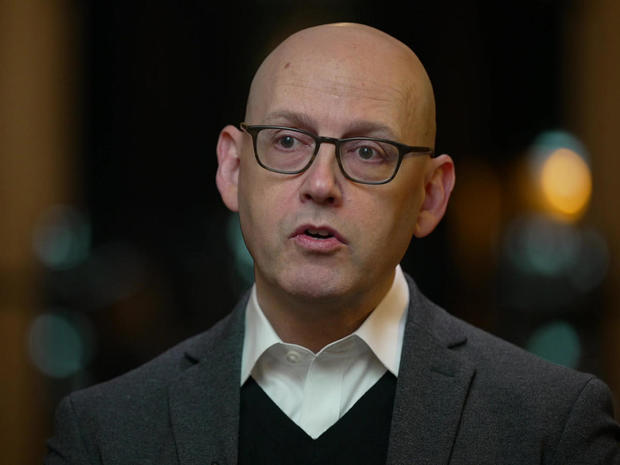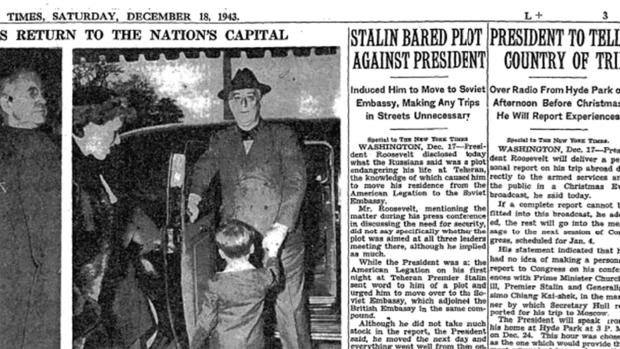“The Nazi Conspiracy”: The World War II plot to kill FDR, Churchill and Stalin
In 1943, Hitler’s army, mired in the brutal conditions of the Eastern front in Russia, was finally showing cracks. To coordinate strategy essential to turning the tide of the war, and with the fate of the free world hanging in the balance, U.S. President Franklin D., Roosevelt, British Prime Minister Winston Churchill, and Soviet Premier Josef Stalin planned their first-ever face-to-face meeting.
Author Bruce Meltzer said such a summit was important because, “This is the moment where the Big Three have to get on the same page. They’ve got to discuss troop movements. They got to discuss logistics. More important, they’ve got to discuss strategy and morale.”
When the Nazis learned of the summit, they hatched an audacious plan, said Meltzer: “They’re going to kill FDR and Churchill and Stalin in one shot, a triple assassination. That’s going to change the course of the entire war.”
Flatiron Books
This little-known (and still never fully-verified) wartime plot is the subject of a new book by Meltzer and Josh Mensch: “The Nazi Conspiracy” (Flatiron Books), which follows their previous bestsellers, “The First Conspiracy” and “The Lincoln Conspiracy.”
READ AN EXCERPT: “The Nazi Conspiracy”
Axelrod asked Meltzer, “The Allies defeating the Nazis – that was not a foregone conclusion in 1943, was it?”
“It seems so obvious now,” he replied. “It’s one of those moments in history where the United States did good, did the right thing, and saved the day. But it didn’t almost go that way.”
The Soviets were shouldering the heaviest burden of any of the Allies. Stalin was desperate; the Nazis had surrounded Leningrad in a brutal siege. “There are nearly a million people who die,” said Meltzer. “The starvation starts immediately. There’s nothing to eat. So, they’re looking at their dogs, they’re looking at rats, and then, they’re looking at each other.”
To relieve pressure on the Eastern front, Stalin wanted FDR and Churchill to open a Western front by invading Nazi-held France, an idea Churchill had been resisting. Stalin proposed meeting in Tehran at the end of November to discuss it – a proposal that didn’t stay secret. According to Meltzer, the Nazis had actually cracked the codes in cables sent between Churchill and FDR.
CBS News
When the war started, Tehran was German-controlled. By 1943, the Soviets and British held it, though many Nazi sympathizers remained. In Meltzer and Mensch’s telling, on the eve of the summit, the Nazis parachuted a team of assassins into Tehran. Many were captured, but six were still on the loose.
Enter Mike Reilly, the head of FDR’s Secret Service detail. “We’re truly 24 hours from the summit, and the Soviets tell him, ‘Listen, we think someone’s going to kill the Big Three,'” said Meltzer.
With Churchill already safely ensconced in the British Embassy near the Russian compound in the city, Reilly makes a crucial decision: to move FDR from the American camp where he’s staying, in the desert outside Tehran, to the more secure Soviet Embassy.
“Secret Service Agent Mike Reilly, he’s the guy who looked the Russians in the eyes, heard the evidence, and thought FDR and Stalin and Churchill, their lives were in danger. They could be killed in this moment,” said Meltzer. FDR and Churchill agreed.
But getting FDR through the city, with Nazi assassins possibly on the route, required a daring drive, and a crucial bit of deception. A motorcade heading toward the Soviet Embassy contained a passenger impersonating the president. “FDR is hiding in a junky old car that’s racing through another part of the city,” said Meltzer, “where there potentially are six snipers, six paratroopers, somewhere out there. And it’s the greatest thing you can ever use, it’s like any magician uses: it’s distraction. And they get him to that Russian Embassy so that they can start that summit.”
The Americans got what they wanted: FDR’s safety. But so did the Soviets. “FDR’s room is bugged,” said Meltzer. “There’s microphones in the walls, there’s microphones in the carpet.”
When Nazi agents were rounded up the same day, Meltzer writes, a spy sent a message back to Berlin: the plot had been discovered. Maybe the assassins were ordered to stand down … or maybe the Soviets made up the entire story, in order to eavesdrop on FDR. Either way, the summit went on safely.
© CORBIS/Corbis via Getty Images
When asked if she thought there was enough evidence to support the idea of the Nazi plot, historian Lynne Olson, who has read Meltzer and Mensch’s book (and who has written bestsellers about World War II herself), said no: “I don’t think there is enough evidence, at least not enough hard evidence, enough objective evidence.”
“Mike Reilly said it happened?” said Axelrod.
“Mike Reilly only knows what a Russian official told him,” Olson replied. “His top priority, his only priority, was to keep Roosevelt safe. It fit into his plans, or it fit into his wishes perfectly.”
“As an intellectual exercise, is there anything wrong with asking: What if?”
“Oh gosh, no! No, there’s absolutely nothing wrong with asking, What if?” Olson said. “The problem is when you raise what-ifs, but you’re acting like it’s real. It might have been better as a novel!”
The summit paved the way for an Allied victory, being the moment when, according to Meltzer, Churchill finally said, “You’re right, I’m in. Normandy is going to happen.”
GALLERY: D-Day: When the Allies turned the tide
When Roosevelt returned home from Iran, he told reporters, “I got word from Marshall Stalin they had word of a German plot.”
The New York Times
“Those aren’t anyone else’s words; that’s the president’s words,” said Meltzer. And that’s good enough for him.
Axelrod asked, “If you can’t be 100% sure that this actually happened, why write the book?”
“Because the story still exists, whether I write it or not,” he replied. “We know for sure that the Secret Service said there’s a plot to kill him. Just because it didn’t happen doesn’t mean the story didn’t exist. That’s a story worth investigating.”
For more info:
Story produced by Jay Kernis. Editor: George Pozderec.
See also:
For all the latest Automobiles News Click Here
For the latest news and updates, follow us on Google News.






